Reading Room Search
Go here for complete Reading Room Article Index
Displaying 501 - 525 of 607What's Wrong with the Ratings?
By Barbara J. Wilson, Ph.D. Please note: This article was originally written for Media&Values Magazine in the early 1990's. Although ratings systems have changed since then, some of the ideas about how ratings evolve are still relevant.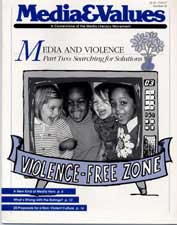
"I saw plenty of media violence when I was a child and it didn't hurt me."
"Everyone knows it's just entertainment."
"It's only a cartoon, everyone knows it's not real."
"As long as I go to the movies with my kids, it's OK."
If you follow the public debates over media violence, you may be familiar with arguments like these. Made by adults from an adult perspective, they dismiss and discredit the problem of media violence for children. But I suspect few of these complacent critics understand how a child really sees the violence in a movie like "Teenage Mutant Ninja Turtles" or a video... Read More
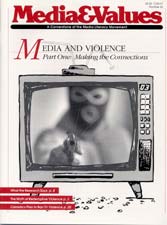
Violence is the ethos of our times. It is the spirituality of the modern world. What is generally overlooked is that violence is accorded the status of a religion, demanding from its devotees an absolute obedience-unto-death.
Its followers are not aware that the devotion they pay to violence is a form of religious piety, however. Violence is so successful as a myth precisely because it does not appear to be mythic in the least. Violence simply appears to be the nature of things. It is what works. It seems inevitable, the last... Read More

Violence is the foundation of many films, TV movies, and action series. In fact, violence is often synonymous with "action." Because screenwriters, directors and producers use violence often and in many ways, how do we begin to recognize the distinctions in media violence? How do we determine if shootout or fist fight is one too many? One way is to understand that there is a basic formula to the portrayal of violence in TV, movies and video. Here are the three basics of the formula, plus questions to help you recognize them:
1.... Read More
All Power to the Conglomerate
If Information Is a Commodity, What Price Is International Understanding? by Stewart M. Hoover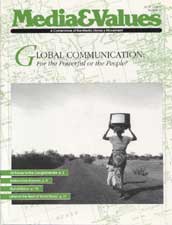
On October 4, 1957, a rocket took off from an isolated plain near an obscure village in Siberia. Called Sputnik, its successful penetration of the earth's orbit created a furor in a Western world that feared its advent heralded a Soviet "victory" in the Cold War.
An even more important, yet less heralded, launching took place six years later. Telstar, the pioneer communication satellite, became the first of a swarm of orbiting satellites that power our present worldwide communications network.
Of the two events, our ever-growing ability... Read More
STARTING POINT: Wrestling with Television -- 15 Years of Cutting Edge TV Criticism
How Media&Values magazine helped set the stage for media literacy in the US. By Elizabeth Thoman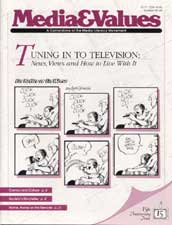
There's a provocative new book currently making the rounds by a man who, aided by a host of friends with VCRs, watched all 24 hours of TV programming sent out on May 3, 1990 on the 93 channels of the nation's largest cable system.
He then compared it to the knowledge he gained from spending 24 hours on a mountain near his Adirondack home.
What we learn from TV land pales by comparison, of course, to the experience of living in the woods even for one day. But The Age of Missing Information by Bill... Read More

A mother comes into the family room where her son is watching a noisy action/adventure show with his school books spread across his lap.
"Michael, how can you watch TV and do your homework at the same time? Homework is important! It should be taken seriously! And seriously means giving it your undivided attention." Without replying, the teenage boy moves slowly and reluctantly out of the living room and upstairs to his room--where he turns on his boom box before returning to his books.
A... Read More
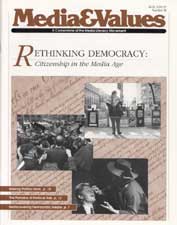
Roger Ailes, media advisor to presidents Reagan and Bush, once told a reporter: "You get up every morning and try to figure out how to humiliate my client. I get up every morning and try to figure out how to make him look good. I sleep better."
The point Ailes wanted to make--that he deserves to sleep better than most reporters--may be questionable. As a public relations expert, however, he does enjoy an advantage over most reporters in his understanding of his task and how it relates to public opinion... Read More

Throughout this issue we address the media's mandate to provide meaningful political discourse, an abstract phrase that we struggle to define.
But there's nothing abstract about the object lesson we all received here in Los Angeles this Spring on what can happen when political discourse fails. If I have any doubt about its concreteness, all I have to do is walk down the street and look at the boarded up appliance store in the mini-mall and the charred front of the little Mom and Pop store... Read More
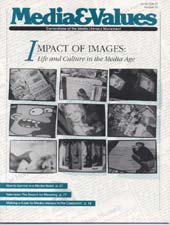
Printed and dispersed widely in the latter decades of the nineteenth century, advertisements provided a vehicle by which urban life could be presented to the countryside and urban industrial values promulgated among rural folks.
A notable example of this was the massive distribution of the Sears-Roebuck Catalog among American farmers from the 1890s on. For many in the countryside, the advertisements in the catalog provided the first glipse of the city. Upon the crowded, densely printed pages of the catalog -- dubbed "America's... Read More

In television most programs are produced by independent production companies who then sell their product to the networks. The networks recoup their expenses and derive profit by selling audience time to advertisers for spots within these programs. The content of television programs in this context is structured by at least three considerations. First, the program has been able to attract large numbers of people to watch it. It cannot therefore appeal to too narrow of a minority.
Second, the program has to attract the "right" kinds of... Read More

Frances Moore Lappé, longtime social philosopher and author of the pioneering study of food resources, Diet for a Small Planet, and educator, public policy expert and African-American community activist Paul Martin Du Bois, are cofounders of the Institute for the Arts of Democracy, a resource center for reexamining the role of citizenship and democratic participation in modern society. They are currently writing a book, Doing Democracy, that will deal specifically with the difficulty of... Read More

If traditional culture defined a world where only the wealthy had access to beautiful color pictures--oil paintings--the proliferation of advertising images put, for the first time, colorful works of art in the hands of the masses. Today color lithography is everywhere and appears pedestrian, yet to its first recipients it bore tremendous symbolic power. For people schooled by an historic scarcity of images, the appearance of chromolithography seemed revolutionary.
It made the symbolic accoutrements of wealth available to everyone... Read More

Television has the connotation of plenitude; it seems to embody consumer society as a whole. In many households, a television set is on most of the day, the pictures and sound adding up to a steady accompaniment -- or is it a secondhand life? Available at the touch of a button during almost all hours of the day, its range of choice at times appears to be synonymous with American freedom. For those who do not subscribe to cable, and for almost all the audience during most of the history of television, the flow even appears to be free (... Read More

We see them everywhere: on billboards, in magazines, on bus placards. They come in the mail and in our Sunday newspapers: glossy pictures of women and men in silk robes, pictures of electric twin-foil shavers and Dirt Devil hand-held vacuums. And we see them on TV: living rooms with two sofas, white-lighted football stadiums, even Wild West gunfight and bloodstained murder scenes. Images. They are so compelling that we cannot not watch them. They are so seductive that they have revolutionized human social communication. Oral and written communication are in decline because a new form... Read More

Like most middle-class children of the 50s, I grew up looking for the American Dream. In those days there were no cartoons in my Saturday viewing, but I distinctly remember watching, with some awe, Industry on Parade. I felt both pride and eager anticipation as I watched tail-finned cars rolling off assembly lines, massive dams taming mighty rivers and sleek chrome appliances making life more convenient for all.
When I heard the mellifluous voice of Ronald Reagan announce on GE Theatre that "Progress is our most important product," little... Read More
Lessons Learned: How to Evaluate War Reporting
Learnings from the first Gulf War. By Angela and John Powers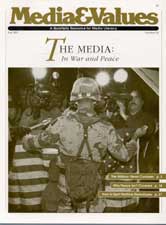
In coverage of the war in the Middle East, as in coverage of earlier wars, "quicker" seemed to be better, and "quickest" best. From Edward R. Murrow's descriptions of the London bombings during World War II, through television's sweeping nightly coverage of the Vietnam War, a trend toward immediacy developed which today manifests itself as the modus operandi for American television news. This ratings-fueled production ethic, however, may have compromised the effective mass communication vital to sustaining our democracy. Despite the volume of wartime information available through the... Read More

To many, the Persian Gulf War was a tragedy, to others a successful crusade. To Sam Keen, the writer, teacher and scholar of religion who wrote Faces of the Enemy: Reflections of the Hostile Imagination, and Fire in the Belly: On Being a Man, it was the latest example of the age-old fallacy of projecting our "shadow side" onto a mostly unknown, faceless enemy. M&V editor Rosalind Silver interviewed Keen about the images that shape war, peace and the media's role in creating them. M&V: Can you explain what you mean by "the hostile imagination?" Keen: We first kill people with our... Read More
Military-News Complex: What Determines What We See and Hear
Three ways the Gulf War was sold to the American public. By William F. Fore
Students of television have identified more than one way of viewing its role as a cultural force. Recognition of the meanings it transmits, the way its programming is driven by economic considerations and its role in gratifying audience needs all provide important tools for analyzing its role in shaping societal goals and values. This applies even more effectively when attitudes are being shaped for a major societal effort such as a war. When we apply these three analytical methods to TV images of the Gulf War, some important insights into television's biases and cultural power... Read More

"Doublespeak is not lying, nor is it merely sloppy language. It is the intentional use of euphemisms, synonyms, jargon, and vagueness which pretends to communicate but really does not, or implies the opposite of what it would appear to communicate." --- Metta Winter, Christian Science Monitor
For centuries before George Orwell coined the word "doublespeak" to convey the flavor of government-sponsored linguistic deception, soldiers have used language to mask the horror of war.
Military jargon has always specialized in turning gore into glory. Many modern conflicts... Read More

Popular films articulate the desires, fears and aspirations of our culture. Analysis of recent war films can shed light on cultural beliefs about heroism, politics, the military and views of authority, justice, patriotism, family and gender relationships.
The following questions can be a starting point for analysis of such films as Rambo: First Blood Part 2, Top Gun, The Star Wars Trilogy, Red Dawn, An Officer and a Gentleman (pro-war) and Das Boot, Apocalypse Now, Platoon, Full Metal Jacket, Casualties of War (anti-war), or add... Read More

Recruiting ads are all around us. Instead of tuning them out or turning the page, put them on the agenda of your study or discussion group. Plan one -- or both -- of these activities for a future class or group meeting: Pick up a selection of youth, sports and minority publications (Boy's Life, Scholastic Scope, Sports Illustrated, Ebony and Hola!, among others) at your local newsstand or library. Copy or clip the recruiting ads. Display them in your group and discuss: What is the appeal in each ad? Is it realistic? To what age... Read More

Like many other media events, the lure of Persian Gulf war profits brought out the worst in many marketers. Not patriotism, not pride, not even the prospect of peace seemed as important for many as the commercial value of these ideals.
"We're trying not to do things to commercialize the war," a spokesperson for a prominent Washington, D.C. department store claimed during the conflict. Such restraint shows respect for the men and women involved in the armed forces and makes a sober statement about war's deathly realities. It also... Read More

The day after the war with Iraq began, I sat in front of my television and listened to a young white U.S. fighter pilot brag about his first bombing mission over Baghdad: "We scored a touchdown, and nobody was home!" I had been paying attention to the impact of the Gulf crisis on women for months, but this pilot's declaration of victory, made just 10 days before the Superbowl on January 27, raised new questions.
As the pilot's comment sank in, I wondered: Do these pilots really think that... Read More

With Canadian troops serving in the United Nations task force and U.S. television beamed across the border, Canadian perspectives of Gulf War coverage were often similar to US views.
Like Americans, most Canadians probably believe that authorities are justified in muzzling the news for security reasons in wartime--even though no one can point to a single Canadian military life lost as a result of disclosure of sensitive information since at least 1946.
The probably related belief that the media "lost"... Read More

Before you finish reading this column three people will die of lung cancer associated with cigarette smoking. The chances that one or two of those people will be a person of color has increased significantly over the last decade. The targeting of blacks in cigarette advertising became a matter of special concern in February 1990, when R.J. Reynolds Nabisco announced that the company would begin the test marketing of Uptown, a brand of cigarette specifically designed and marketed to attract African Americans. During that same week, Dr. Harold Freeman, director of surgery at Harlem... Read More

